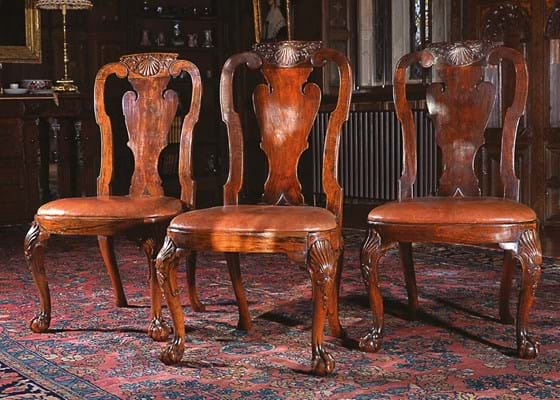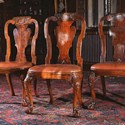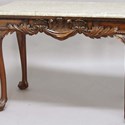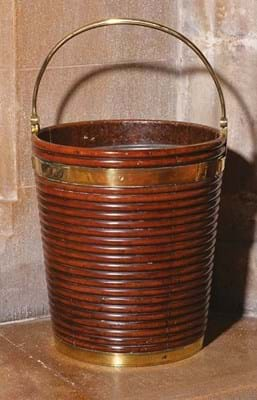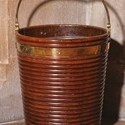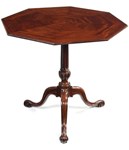No balance sheet has ever factored in the pleasure British antique furniture provides to its owners over the years.
Viewed in cold financial terms, two fine collections assembled since the late 1960s that were sold in spring probably represented a loss in money terms. But both included fine objects that were eagerly sought by a new generation of buyers.
Price tags attached
The Lawrences (25% buyer’s premium) sale at Crewkerne on April 12 included a consignment of furniture with receipts from the late 1960s and early 70s. These were the years just before antique furniture took off and, even allowing for inflation rates of between 10-15 times prices back then, most of the pieces appear to have just about maintained their value.
The consignment comprised a George II mahogany side table, illustrated on this page, a Regency tub chair and a sofa and pair of armchairs by Howard & Sons.
Topping the day, the 3ft 10in (1.17m) wide side table had a grey marble top above a frieze with Prince of Wales feathers. A receipt showed it had been bought from Gloria Antiqua in Brompton Road for £875 in 1970.
Against an estimate of £1500- 2500, it sold to a private UK buyer at £15,000.
The mahogany tub chair in the manner of Thomas Hope, with curved and carved back rail, down-curved arms and drop-in leather seat on carved front legs and splayed back legs, was bought in 1969 from WR Harvey of New Cavendish Street for £235. Pitched at £1500-2500 in Somerset, it sold to another private bidder at £4200.
The lasting popularity of upholstered furniture by the 19th- 20th century London maker Howard & Son was underlined in the case of a pair of Bridgewater chairs, and a two-seater Seymour sofa.
They had been bought in 1973 at the Grosvenor Street business of Lenygon and Morant, the long-established cabinetmaker which took over Howard & Sons in 1935.
The early 20th century chairs, in original Howard green printed upholstery had cost £99.60 each. Estimated at £1200-1800, the pair at Lawrences sold for £5000.
The similarly upholstered 5ft 7in (1.7m) wide sofa had cost the vendor £212.30. As with the chairs, it kept its value at Somerset, selling to a private bidder for £3600 against a £1000-1500 estimate.
Chinese chairs at Dreweatts
Among the pieces consigned to the Dreweatts (25% buyer’s premium) auction at Newbury on May 15 from Plaish Hall in Church Stretton was a set of three Chinese padouk wood chairs.
Dated to c.1735, they were early examples of hardwood furniture made in Canton to an English design, in this case the important London cabinetmaker Giles Grendey (1693-1780).
The chairs, probably part of a larger suite commissioned by a British merchant or East India Company employee, are a rare design but similar examples do crop up from time to time. A closely related single armchair took $16,000 (then about £10,000) at Christie’s New York in 2014.
Dreweatts estimated its trio at £15,000-20,000 and they sold to the UK trade at £36,000.
Complete with chimneys based on those at Hampton Court, Plaish Hall, a Grade I-listed Tudor house, is thought to be the first brick-built house in Shropshire. The sale, conducted for the family of the late Roy Merley, comprised 285 lots of which 82% got away to hammer £433,000.
The single consignment, bought as it was from leading London dealers and auction houses in the boom years from the late 1970s to the turn of the 21st century, probably represented a loss in money terms – but, again, financial factors do not count the pleasure gained over the years.
Private buyers bid a shade above estimates to take two mahogany breakfront library bookcases including a Scottish example with a brass plaque reading Newall & Reid, Fecit Dumfries.
Walter Newall’s name first appears in the Dumfries Weekly Journal in a notice about a local cabinet maker’s business, Hannah and Reid. John Hannah announced he was taking a back seat for health reasons and recommended his partner John Reid and Newall to his customers.
By 1814 the firm collapsed and Newall established himself as an architect, responsible for many of the late Georgian classical and Greek Revival buildings in Dumfries and Galloway. The 8ft tall by 11ft wide (2.76 x 3.34m) bookcase sold at £6500.
Irish peat buckets were great favourites in the boom years but here a c.1780 mahogany and brass-bound example was given a 21st century estimate of £500-700. Catalogued as ‘possibly Irish’, the 17in (43cm) tall bucket with removable lead lining and original brass handle went to a private buyer at £3400.
Another offering to leave its estimate behind was a typical c.1690 kingwood oyster veneered casket with brass mounts and carrying handles. With a hinged top and front opening to reveal two drawers, a hidden slide and concealed compartment, the 15in (39cm) wide casket pitched at £1500-2500 went to the trade at £6500.


